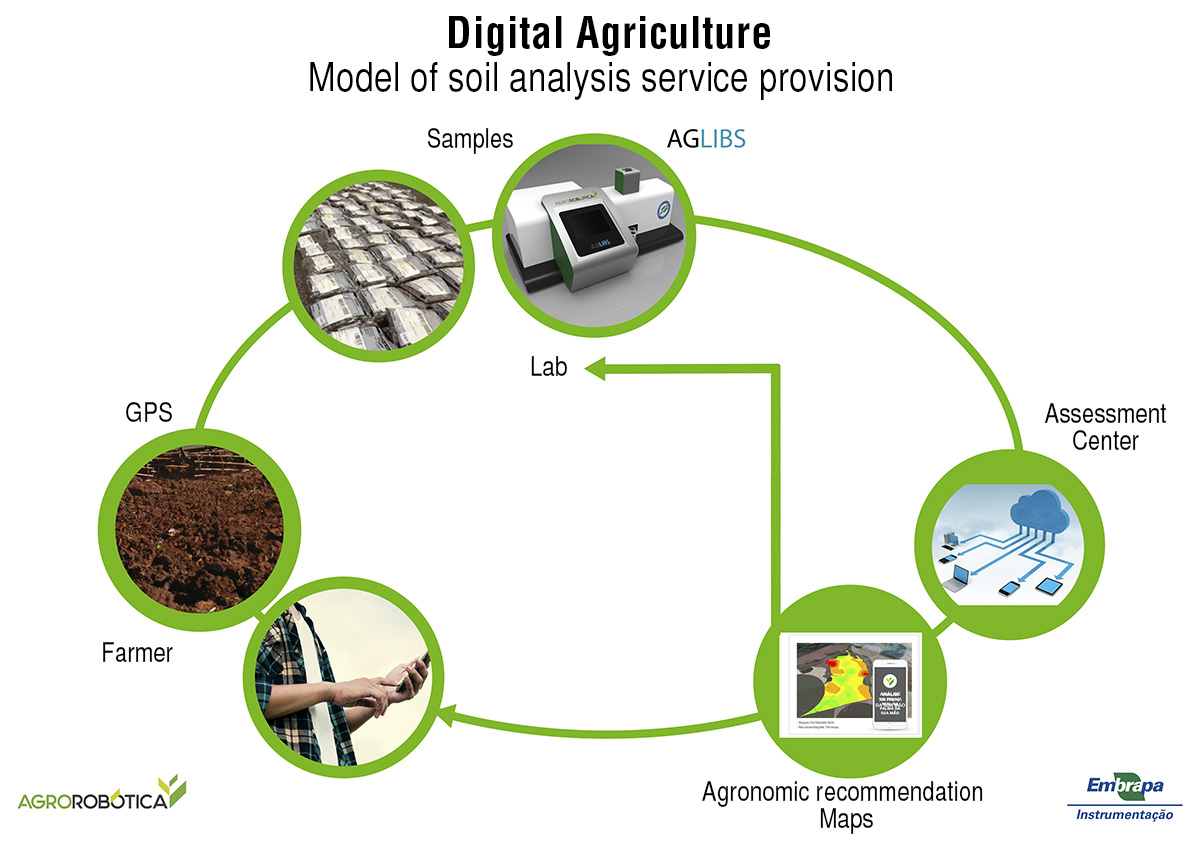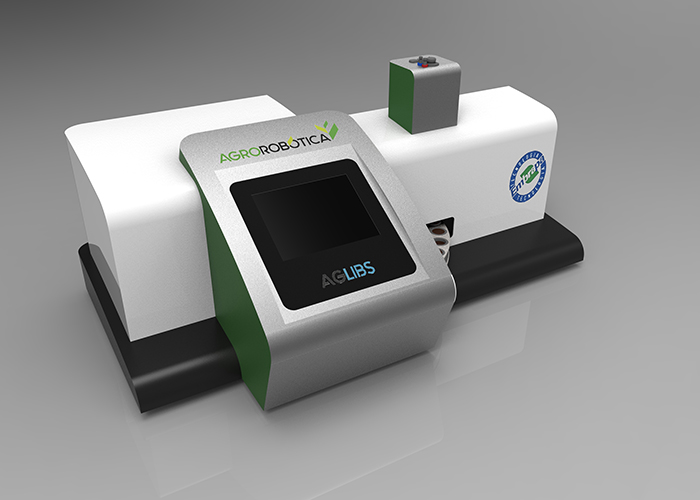Embrapa Beef Cattle
Technology uses laser and artificial intelligence for large scale clean soil analysis
Brazilian scientists developed an equipment with last generation technology that will bring quick, clean and affordable soil analysis to farmers. The innovation does not generate chemical waste and is capable of analyzing 1,500 samples per day and of supplying data on the amount of soil organic carbon, texture (sand, silte and clay contents) and pH.
AGLIBS 1.0 uses Laser Induced Breakdown Spectroscopy (LIBS), the same boarded onto the Rover Curiosity, a robot by the North American Space Agency, Nasa, to discover the presence of water in Mars. The technology is being pioneered in Brazil and allows for in-laboratory real-time assessment, whereas conventional analyses take a few days to yield results. The equipment will be showcased at Embrapa's stand in the Agrishow, in Ribeirão Preto, SP, from April 30 to May 4.
he new technology is the first result of the partnership between Embrapa Instrumentation 'sinnovation ecosystem with an agribusiness startup (agritech). This union gave rise to Agrorobótica, founded in 2015, which will make the technology available to the market in the first half of 2018. The startup based in São Carlos was one of the seven selected in the program Pontes para Inovação (Bridges for Innovation), an initiative from Embrapa and Cedro Capital to boost partner agritechs.
Artificial intelligence and franchising
The company has bet in a differentiated model of service provision for the new technology. AGLIBS will be franchised to laboratories, cooperatives, resales and precision agriculture companies. The farmer will submit georeferenced soil samples to a franchise and the result will be sent to one of Agrorobótica's analysis centers, where an artificial intelligence model will calculate the parameters desired.
Mauro Angelis, one of the partners of the company, reports that with the help of the hardware and software on board, the data on the elements and molecules are transformed into agronomic information. “The results of the carbon, texture and pH analyses are digitalized in seconds and stored in the cloud, and real time agronomic recommendations iare provided both to the farmers and to the franchisee”, he describes.
“Such information is important for farmers, because it indicates the correct dosage of agricultural inputs to be applied for soil correction, preventing their insufficience or excess as well as unnecessary expenses, not to mention the contribution for the preservation of the deposits of correction minerals and non-renewable fertilizers”, adds Mauro Angelis.

Art by: Thiago César
From Mars to the fields
The LIBS methodology, an acronym for optic emission spectroscopy with laser induced plasma, is remarkable for the advanced onboard technology in comparison with other techniques. In accordance with the PhD in physics Aida Bebeachibuli Magalhães, another of Agrorobótica's partner, the technique allows the equipment's operational capacity to total around 360,000 annual sample analyses, which are performed without generating chemical waste. “Such volume is almost twice the number of analyses performed by large laboratories in Brazil that use traditional methodologies involving 13 processes”, the scientist asserts, stating that the new technology resorts to a single process.
With over 15 years' experience in the use of optics and photonics, the Embrapa researcher Débora Milori explains that LIBS was deployed because it is a technique that analyzes a sample with little or no preparation; it is a fast, low-cost system; and it can identify elements simultaneously in a small sample like 0.5 gram, for instance.
Milori explains that the LIBS system casts a high energy laser into the sample, generating plasma that emits light deriving from the atoms and ions that are present in the soil. “The light emission from each element is like a fingerprint that makes it possible to identify the atom that is in the plasma. That is how we can quantify soil carbon, nutrients and contaminants”, the scientist clarifies.
Project of a LIBS system (Source: http://www.appliedphotonics.co.uk).
Latest technology accessible to farmers
The development of the AGLIBS started in 2015, parallelly to the establishment of Agrorobótica, as the group of researchers from the startup and from Embrapa Instrumentation observed that many farmers did not have their soil analysed due to its high cost, leading them to apply agricultural inputs without agronomic recommendations, a fact that generates a lack or excess of minerals and fertilizers in the croplands and compromises agricultural productivity.
According to Aida Magalhães, another reason was the need to develop an equipment that could perform the analyses on a large scale without losing quality, and that was economically viable. “We have been receiving soil samples from several laboratories in Brazil to test and compare traditional methods and with the AGLIBS. To each analysis in them we certify the analytical results more than and of the efficiency of our technology”, it counts.
Bar codes identify the samples
In three years of calibration, AGLIBS has already analyzed over 2,000 tropical soil samples from several Brazilian regions. The samples collected in the fields with the help of a free app to records their location are received by franchisee companies with a pre-identification with bar codes containing information on the customer and type of service to be performed. The samples then go through a process of drying followed by milling. The next step is to turn the sample into a tablet to be analyzed by the AGLIBS in seconds.
The importance of quantifying carbon
The innovation can directly contribute to the certification of rural properties in the Brazilian Government's Low Carbon Agriculture Plan (Plano ABC) as it requires a digital tool to measure carbon in real time in a laboratory without generating waste.
But the benefits do not stop there, as AGLIBS also allows the generation of fertility maps, and directly influences reduced costs from the application of inputs and increased crop productivity. The equipment can analyze any type of soil in the domestic territory or from abroad, with prior calibration.
Intelligent robots will analyze croplands“Within the scope of our aim to connect intelligent robots with technologies and people, making possible higher efficiency, sustainability and yield in the so-called agriculture 4.0, we are already working in models for the quantification of soil macro- and micronutrients in partnership with Embrapa Instrumentation that will soon be available for farmers”, the partner Fábio Angelis adds. “Technological innovation does not stop, we have worked on other applications of photonics and optics for agriculture and the environment. One of them, in partnership with Agrorobótica itself, is the soil organic matter quality sensor, which uses the LIFS ( Laser-induced Fluorescence Spectroscopy) technique, which could even generate businesses related to carbon credits”, informs Débora Milori. |
Translation: Mariana Medeiros
Joana Silva (MTb 19.554/SP)
Embrapa Instrumentation
Press inquiries
instrumentacao.imprensa@embrapa.br
Phone number: +55 16 2107 2901
Edilson Fragalle (MTB 21.837/SP)
Embrapa Instrumentation
Further information on the topic
Citizen Attention Service (SAC)
www.embrapa.br/contact-us/sac/


